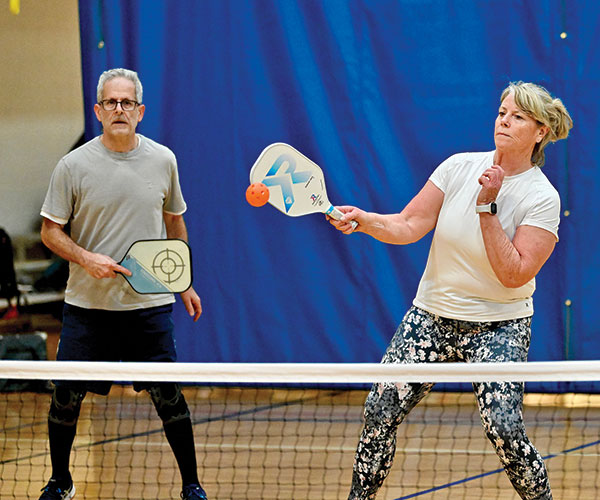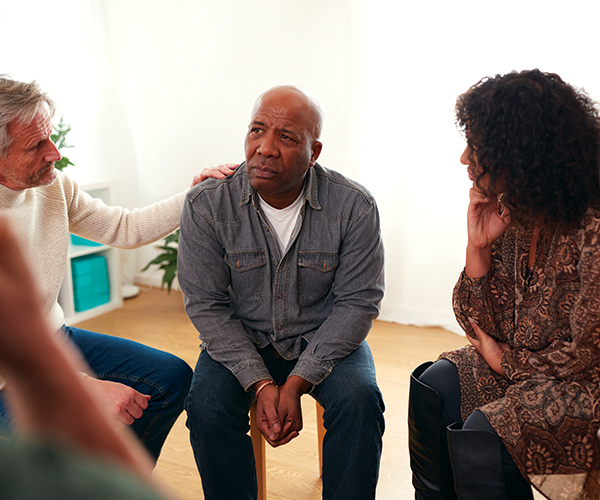From the roof of Judson Manor, Virginia Havens has a stunning 180-degree view of University Circle. High above the trees, she overlooks the Cleveland Museum of Art lagoon and the entire campus of Case Western Reserve University, where at 90 years old, she still takes classes.
In fact, her current philosophy class on War and Morality is the ninth course she's taken there. She points out the Kelvin Smith library, where she researches her term papers — even though by auditing the class, she can choose whether to write them.
"It's irresistible," she says, of living so close to a campus that allows her to audit classes. It's also a way to fit in part of her daily 2-mile walk.
"You get over there and you get all vibrant," says Havens, who has lived at the independent living facility with her husband, George, for six years. "It's so exciting to learn that I'm never going to grow old."
Because of its proximity to CWRU, Judson started a partnership with the university to allow its residents to audit classes and use the campus facilities.
Havens has never let age be an obstacle. After raising three sons, she earned a master's in education from CWRU in her 40s and started teaching in Cleveland schools at 45. When she retired, she began teaching job-interview skills to convicted felons — a volunteer activity she still does with Towards Employment.
Maintaining vitality in later years is a trend that others in the senior living industry see as well.
"Individuals are looking at not only things they'd like to pursue in retirement, but they also want to make sure they stay contributing to greater society in gainful work and activity," says David Schell, executive director of Breckenridge Village in Willoughby.
Along with that, Schell says, Breckenridge has residents who are semiretired. "They aren't fully disengaging from the workforce," he explains. "Part of it is driven by economics, but a larger part is just the desire to do what they enjoy doing but doing it in terms that's workable for them."
For those who do retire, senior living communities are offering ample ways to stay active in the community.
Hank Kurdziel, 90, and his wife, Pat, 85, moved from a condo in Mayfield Heights into Breckenridge Village two years ago. Kurdziel continues to volunteer with Meals on Wheels in Lyndhurst and visits friends.
Two years ago, Kurdziel became part of a residents group, which established college scholarships for high school students who worked in food service at Breckenridge Village. The group set criteria for an essay contest and a personal interview to qualify. This past year, they gave scholarships ranging from $250 to $2,000.
For Kurdziel, who spent his life in education and retired as superintendent of South Euclid-Lyndhurst Schools, it allowed him to use his educational background to set the scholarship standards, do the interviews and judge the essays.
"I went into teaching because I like to work with young people," Kurdziel says. And the program helps him stay connected to what he loves. "It gives me a very positive feeling to be with them and to feel the world is going to be OK with the next generation."
For those residents who may no longer be physically or mentally able to work or volunteer, senior living facilities frequently engage nearby resources to bring in programs or volunteers to broaden the residents' connections to community.
"It becomes a lifestyle," says Lee Ann O'Brien, director of community relations, special projects and planned giving at the Gardens of McGregor.
McGregor offers many programs, including a community garden tended by residents, family and community members to raise herbs and vegetables that the kitchen staff then serves to residents.
One of the most popular programs, says O'Brien, is Planting Partners, which pairs a resident and volunteer to plant container gardens in the spring. It creates more than 225 gardens throughout the property.
"They put a stake in it with their name on it and it becomes something they can be proud of," O'Brien says. "Then we can take them outside to check on it or water it and watch it grow."
Activities are just one part of person-centered care, which senior living facilities vow is more than a new buzzword in the industry.
"Person-centered care is really knowing the person inside-out and backward," says Dresden Leebron Cincurak, divisional dementia care manager for Brookdale Senior Living. With more than 20 senior living facilities in Northeast Ohio, Brookdale works with family members to understand a resident's life story — their passions, personality and quirks.
"We can build programming around them and ensure that they have an engaging and purposeful and meaningful day," she says.
Many facilities have forgone a strict schedule of planned meals and activities throughout the day for a more flexible schedule tailored to each resident.
"Whatever they were doing at home, we duplicate that here," says Evan Lubline, administrator at The Weils in Chagrin Falls. "Maybe they weren't getting up until 11; why can't they still do that?"
Person-centered care goes hand-in-hand with a new concept in senior living called the "household" or "neighborhood" model of living. Instead of having rooms off long corridors, for example, the facility is divided into smaller clusters that offer a handful of rooms with a kitchen, living room, name on the door and often private entrances.
In July, the Weils opened a memory care unit for adults living with dementia. The new David and Freda Robinson Residence uses the neighborhood model with three different neighborhoods and six residents per household.
"We wanted to make sure everybody had their own family rooms, visiting rooms and social areas," says Lubline. "Families want to come to a very homelike setting."
Dedicated and specially trained staff can work in the smaller neighborhoods, building connections with residents. "The caregivers become so close to the residents," he adds. "It's a special bond."
The new residence at the Weils also fulfills another growing trend in senior living, the demand for specialized memory units.
But Brookdale's Cincurak cautions that "dementia is not a normal part of aging." Still, she says, an estimated 80 percent of people over the age of 85 have some type of cognitive impairment.
"Currently there's about 3.5 million people with dementia," says Schell of Breckenridge. "By 2025, that's projected to go over 7 million."
"If I were picking out senior living for a loved one," says Cincurak, "I would No. 1 look at their programming and see what they have available and see if it would fit my loved one."
Eliza Jennings, based in Lakewood, offers a special interactive program called Saido, for example. Developed in Japan, the method involves a series of simple arithmetic, writing and reading exercises performed five times per week for about 30 minutes that have shown to help slow memory loss.
McGregor recently implemented a program for its residents with dementia designed to give them each a personalized playlist of music and a pair of headphones, based on a program called Music and Memory.
"One size doesn't fit all," says McGregor's O'Brien, who notes that the right place depends on many factors.
The Weils' Lubline recently experienced the other side of looking for senior living when his grandparents needed more assistance. His parents, who live in Lyndhurst, decided that proximity was one important factor and chose Menorah Park — and everyone is happy.
Such familiarity and proximity to friends and neighbors also means more people are choosing to put off moving to a senior living facility.
"We're seeing more people want to stay home," says Lubline.
So more senior living facilities also are offering home care services and day care to join a continuum of care that often transitions from independent to assisted living to skilled nursing. Many also offer specialized memory care units and rehabilitation facilities.
"People want to stay independent longer," says Rich Boyson, CEO of Eliza Jennings. "If we can bring the services into their homes, that's what they're choosing to do."
Yet, too many people wait until a crisis happens to start looking for a senior living option.
"The ones who have done it earlier are happy that they made the decision," Boyson says. "The ones who have done it later typically say, •I should have done this five years ago.' "
Take Virginia and George Havens. When they first retired, they moved to a mountaintop in Montana to enjoy the outdoors. But as they aged, they realized that they would be isolated should something
happen. When they moved back to Northeast Ohio, they wanted an urban setting with the arts and restaurants in walking distance to their home.
But they still enjoy traveling and celebrated her 90th birthday in October in Paris. She has no plans to stop traveling, walking, volunteering — and taking classes.
"The point is to keep on living until you die, if you're physically able," says Havens. "There's so much to do, and it's so much fun."
tought talk
Discussing care issues doesn't have to be a scary proposition.
David Schell loves to walk through the Veale Wellness and Aquatics Center on the campus of Breckenridge Village in Willoughby and see 80- and 90-year-old residents pumping iron or doing yoga.
But the executive director also understands there comes a time when residents may not be physically able to work out. That's why last year Schell did something at his annual board of directors dinner that he'd never done before: He asked residents and board members to discuss death and dying over dessert.
"As you can imagine, everyone approached it with a little bit of fear and trepidation," Schell says. But he was surprised at the positive feedback he received from both groups.
"For the vast majority of residents, their desire and interest is not to prolong life but to maintain quality of life," he says. "[They] certainly accept dying as part of life's processes."
Such discussions can be empowering, says Dr. Elizabeth O'Toole, medical director at Judson and the director of geriatrics and palliative care at MetroHealth Medical Center. It's important for people to have them with their physicians as well as with family members, she says.
"[It's] not about taking away hope," says O'Toole. Instead, such conversations give an older person the voice to clarify what they want or don't want in their medical care at all stages of their lives — before an illness, like dementia or a stroke, might take away the person's ability to communicate.
In fact, one of the latest trends in senior living is to provide palliative care — or support for advanced illnesses — to residents.
"People who have been involved [in senior living] will tell you they've been doing palliative care forever," says O'Toole. "They just never called it that."
The trend to formalize palliative care programs in senior living facilities can be confusing to residents and their families, O'Toole admits.
"Very few people know what the words •palliative care' means at all," O'Toole says. "They might hear it with hospice, and they're thinking extreme end of life. Palliative care can be given at any time someone has a serious illness."
Palliative care manages symptoms of a chronic or life-limiting illness, such as pain. But, unlike hospice care, which can be put in place when a physician believes a patient is in the final six months of life, such treatment doesn't have a time limit.
"Dementia is a condition that's a really important place for palliative care," O'Toole explains. "It's such a long, drawn-out process with slow declines that are continuous. It's hard to know when you've turned a corner."
Some senior living facilities require residents have the documentation in place in case of a health care crisis. But too often it's hard enough to choose a facility, so families put off talking about what a patient would want if he or she could no longer speak.
"People plan for their financial retirement," says Rich Boyson, CEO of Eliza Jennings. "But they often don't plan for changes in health or activities of daily living that they take for granted."
Some of the planning that many facilities ask for includes the following documents.
Do not resuscitate or do not attempt resuscitation orders: While cardiopulmonary resuscitation works on TV, real life can be a different story. The American Heart Association says that for people over 70 and in the hospital, CPR works only about 12 to 18 percent of the time. And what many people don't realize is that if patients do survive, CPR can have lasting implications.
"People don't do well, especially people with frail bones," says O'Toole. "You really have to push on people's chests to do compression and that causes damage."
And, she adds, those who do survive often lose cognitive abilities because "older brains" don't bounce back after lack of oxygen caused from the heart stopping.
Advance directives:Although all adults should have a living will and health care power of attorney, these advance directives become even more critical as people age. They do not need to be done by an attorney, but people do need two witnesses.
A living will allows people to say what they would and would not want if they could no longer speak for themselves, such as if they want to remain on a ventilator or have a feeding tube.
A health care power of attorney is a person who can make medical decisions for someone who can no longer speak. This person can be different from a designated financial power of attorney who has control over an estate. It's important for family members and a physician to have copies.
Often Schell finds that adult children struggle with such discussion more than the senior does.
"I think it's a very good and healthy thing to have in place," he says, "even if it's not something that's in the immediate future."
Every so often, as he walks through his wellness center he thinks about the residents still enjoying working out after so many years. And he equates it to making decisions about health care.
"It's not about fitness to extend life, it's about fitness to extend quality of life," he says.




